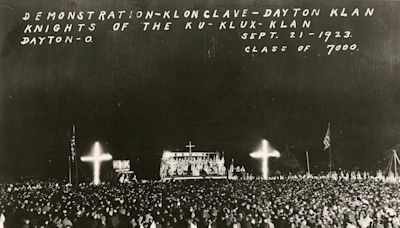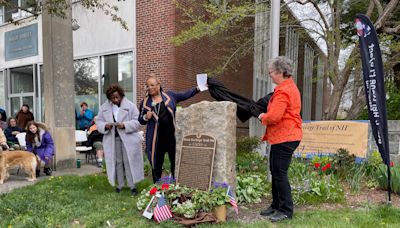Search results
Jun 18, 2020 · Not all black people are African American. Here's the difference. By Cydney Adams. June 18, 2020 / 3:20 PM EDT / CBS News. Black Lives Matter protests have opened up conversations about the ...
- CBS News
- 12 min
- Overview
- Names and labels
- The early history of Blacks in the Americas
African Americans, one of the largest of the many ethnic groups in the United States. African Americans are mainly of African ancestry, but many have non-Black ancestors as well.
African Americans are largely the descendants of enslaved people who were brought from their African homelands by force to work in the New World. Their rights were severely limited, and they were long denied a rightful share in the economic, social, and political progress of the United States. Nevertheless, African Americans have made basic and lasting contributions to American history and culture.
As Americans of African descent reached each new plateau in their struggle for equality, they reevaluated their identity. The slaveholder labels of black and negro (Spanish for “black”) were offensive, so they chose the euphemism coloured when they were freed. Capitalized, Negro became acceptable during the migration to the North for factory jobs. Afro-American was adopted by civil rights activists to underline pride in their ancestral homeland, but Black—the symbol of power and revolution—proved more popular. All these terms are still reflected in the names of dozens of organizations. To reestablish “cultural integrity” in the late 1980s, Jesse Jackson proposed African American, which—unlike some “baseless” colour label—proclaims kinship with a historical land base. In the 21st century the terms Black and African American both were widely used.
Britannica Quiz
Africans assisted the Spanish and the Portuguese during their early exploration of the Americas. In the 16th century some Black explorers settled in the Mississippi valley and in the areas that became South Carolina and New Mexico. The most celebrated Black explorer of the Americas was Estéban, who traveled through the Southwest in the 1530s.
The uninterrupted history of Blacks in the United States began in 1619, when 20 Africans were landed in the English colony of Virginia. These individuals were not enslaved people but indentured servants—persons bound to an employer for a limited number of years—as were many of the settlers of European descent (whites). By the 1660s large numbers of Africans were being brought to the English colonies. In 1790 Blacks numbered almost 760,000 and made up nearly one-fifth of the population of the United States.
Are you a student? Get Britannica Premium for only 24.95 - a 67% discount!
Learn More
Attempts to hold Black servants beyond the normal term of indenture culminated in the legal establishment of Black chattel slavery in Virginia in 1661 and in all the English colonies by 1750. Black people were easily distinguished by their skin colour (the result of evolutionary pressures favouring the presence in the skin of a dark pigment called melanin in populations in equatorial climates) from the rest of the populace, making them highly visible targets for enslavement. Moreover, the development of the belief that they were an “inferior” race with a “heathen” culture made it easier for whites to rationalize Black slavery. Enslaved Blacks were put to work clearing and cultivating the farmlands of the New World.
Of an estimated 10 million Africans brought to the Americas by the trade of enslaved peoples, about 430,000 came to the territory of what is now the United States. The overwhelming majority were taken from the area of western Africa stretching from present-day Senegal to Angola, where political and social organization as well as art, music, and dance were highly advanced. On or near the African coast had emerged the major kingdoms of Oyo, Ashanti, Benin, Dahomey, and the Congo. In the Sudanese interior had arisen the empires of Ghana, Mali, and Songhai; the Hausa states; and the states of Kanem-Bornu. Such African cities as Djenné and Timbuktu, both now in Mali, were at one time major commercial and educational centres.
- Hollis Lynch
African Americans, also known as Black Americans or Afro-Americans, are an ethnic group consisting of Americans with partial or total ancestry from any of the Black racial groups of Africa. [3] [4] African Americans constitute the third largest racial or ethnic group in the U.S. after White Americans and Hispanic and Latino Americans. [5]
Oct 11, 2023 · The Black or African American alone non-Hispanic population was the third-largest group at 12.1%. We also calculate the diffusion score, which measures the combined percentage of all racial and ethnic groups that are not in the first-, second- or third-largest racial and ethnic group.
Jan 18, 2024 · The analysis identifies the nation’s Black population through self-reports of racial and ethnic identity on the 2022 ACS. The Black population includes single-race non-Hispanic Black people, multiracial non-Hispanic Black people and those who say they are Black and Hispanic. All displayed numbers are rounded.
Jan 18, 2024 · In 2022, there were an estimated 47.9 million people who self-identified as Black, making up 14.4% of the country’s population. This marks a 32% increase since 2000, when there were 36.2 million Black people living in the U.S. Black Americans are diverse.
Mar 25, 2021 · In 2019, 40.7 million, or 87%, identified their race as Black alone and their ethnicity as non-Hispanic, while around 3.7 million, or 8%, indicated their race was Black and another race (most often White) and not Hispanic.




